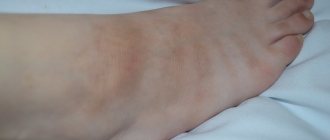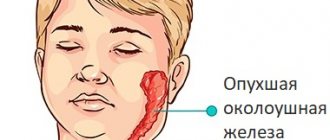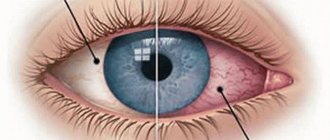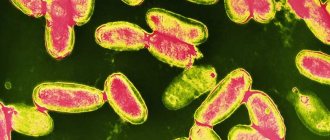Category: Symptoms and conditions
For the full functioning of a person, a stable balance of vitamins in the human body is very important - their role cannot be overestimated.
- Water-soluble vitamins are accelerators of biochemical processes, ensuring normal metabolic functions (metabolism).
- Fat-soluble vitamins have many beneficial properties and are what ensure the strength and health of musculoskeletal tissues.
Vitamin deficiency is a vitamin deficiency, manifested by a significant deficiency or complete absence of a certain type of vitamin in the body. There are many ways for fortified substances to appear in the body. They come with food, are synthesized by the natural flora living in the gastrointestinal tract and accumulate in the skin under the influence of ultraviolet rays.
The development of vitamin deficiency occurs when these processes are disrupted, or in situations where the need for vitamins increases sharply. Based on the severity of the deficiency, hypovitaminosis or avitaminosis is diagnosed. How are these two states different?
Symptoms of vitamin deficiency
There is an opinion that the manifestations of vitamin deficiency are limited to dry skin and hair loss, but there are also a number of specific symptoms of the disease, the appearance of which concerns not only a deterioration in the appearance of the body, but also the appearance of serious pathologies of internal organs and systems. Detection of the disease in the early stages will ensure quick and effective treatment of vitamin deficiency. It is necessary to remember the main symptoms of vitamin deficiency:
- irritated and dry skin;
- hair splits, dandruff appears;
- cracks appear on the lips and in the corners of the mouth;
- red dotted rash on the body;
- bleeding gums;
- reduced immunity: frequent colds and slow recovery;
- drowsiness, low performance, loss of appetite.
If these symptoms of vitamin deficiency are detected, it is necessary to begin treatment immediately, since a lack of vitamins negatively affects the health of all body systems.
Distinctive signs of vitamin deficiency
Unfortunately, it is not possible to diagnose vitamin deficiency immediately, since its initial period is secretive. A person feels drowsiness, apathy, loss of ability to work, and irritability. Further, a lack of vitamins will certainly not have the best effect on your appearance.
The epidermis is especially susceptible to the negative manifestations of vitamin deficiency. This largest human organ by area performs many vital functions. For his health and normal functioning, it is necessary to receive a large amount of vitamins. It is these compounds that are responsible for the water-fat balance, the course of regeneration processes in the skin, its respiration and blood supply.
The distinctive signs of the disease are quite extensive and varied. They can present with internal and external manifestations ranging from dandruff and hair loss, acne and cracked skin, to brittle bones and blindness. The fact is that sometimes the body lacks one vitamin, and sometimes there is a deficiency of several vitamin components at once.
Therefore, if the skin has become dry, with an unhealthy tint, inflammation has appeared, and all this occurs against the background of emotional disruptions, you need to consult a doctor.
Symptoms in children and adults
Only a therapist can diagnose vitamin deficiency.
Based on the test results and presenting symptoms, he will determine which microelement is missing in the patient’s body. Signs of vitamin deficiency include the following:
- Decreased appetite;
- Lethargy and decreased activity;
- Tearfulness;
- Dry lips and cracks in the corners of the mouth;
- Rash on the body.
These are the first symptoms. Further, the lack of a certain vitamin in the baby’s body can cause much more serious deviations:
- Vitamin K deficiency is accompanied by nosebleeds and bruises all over the body;
- A lack of vitamin D will manifest itself as problems with bones and joints, the development of rickets;
- A lack of ascorbic acid (vitamin C) will lead to the destruction of teeth and gums, the formation of ulcers on the body and long-healing wounds;
- If there are few B vitamins , then the child looks weak, lethargic, dermatitis, weight loss, and lack of coordination may be observed;
- An insufficient number of RR compounds at an early age is characterized by rapid fatigue.
Complex forms with a deficiency of several vitamins can provoke cramps, muscle atrophy, mental disorders, and suppression of reflexes.
In adults, increased fatigue and drowsiness do not immediately cause anxiety; they easily explain these symptoms by chronic fatigue, the rhythm of life and daily workload.
However, there are persistent symptoms of this disease in adults:
- Migraines and insomnia;
- Bleeding gums;
- Dry mouth, decreased appetite;
- Mood swings;
- Bone pain;
- Problems with skin and hair.
Certain signs in women
Especially women think about the seriousness of the disease later, when visible signs appear:
- brittle nails,
- increased dryness of the epidermis,
- early wrinkles,
- loss of a large amount of hair.
It is good when these phenomena are temporary. What to do if the symptoms do not go away and the situation gets worse? This should under no circumstances be expected. Because in both children and adults, an advanced form of vitamin deficiency leads to serious consequences.
Types of vitamin deficiency
Each of the vitamins necessary for a person is used for the normal functioning of certain body systems, therefore, with a lack of nutrients, certain internal organs suffer to varying degrees. You need to know what different vitamins are responsible for and what types of vitamin deficiencies exist.
Vitamin A deficiency – this vitamin ensures visual acuity. Lack of vitamin A causes hemeralopia - severe vision impairment in the dark.
Vitamin A is also important for the skin - with vitamin deficiency, it becomes dry, irritated, cracked and heals slowly.
Vitamin deficiency of B vitamins - this disease affects the deterioration of metabolism (constipation, diarrhea, nausea and vomiting). Also, due to a lack of vitamin B, cracks appear in the corners of the lips, and the oral cavity becomes inflamed.
Vitamin C deficiency affects performance and provokes chronic fatigue and apathy. Vitamin C is responsible for the elasticity of the skin - vitamin deficiency causes bruises and hematomas on the body.
Vitamin D deficiency is a condition that causes rickets in children, a disorder of bone formation. With a lack of vitamin D, teeth also fall out and frequent fractures occur.
Vitamin E deficiency leads to diseases of the genitourinary system, is the cause of infertility and the inability to bear a child. The function of the liver is also disrupted.
Vitamin PP deficiency is a disease of the gastrointestinal tract, characterized by loss of appetite, nausea and vomiting, as well as a lack of gastric juice necessary for digesting food. With a lack of vitamin PP, frequent diarrhea and severe abdominal pain are also observed.
In addition to these types of vitamin deficiency, such a specific seasonal disease as spring vitamin deficiency is very common.
Vitamin deficiency affects the skin and well-being
Signs of vitamin deficiency in children, features
In childhood, vitamin deficiency develops gradually. This indicates a slight vitamin deficiency and their presence in the child’s body in the required set. Long walks, adherence to the correct regimen with good sleep and literacy of parents who can immediately discern vitamin deficiency in a child will help prevent the development of the pathological process.
The main symptoms of vitamin deficiency in children are manifested by a noticeable decreased activity and loss of appetite. In cases of “A” deficiency, the child’s skin shows signs of vitamin deficiency - it becomes dry, covered with rashes and pustules that are difficult to treat. The mucous membranes in the mouth and nasal cavity are also dried. Children are lagging behind in development and growth.
With a lack of vitamin substances from the “B” group, symptoms manifest themselves:
- loss of appetite and rapid weight loss;
- inflammatory processes in the tissues of the tongue and the development of stomatitis;
- formation of cracks in the skin, eczematous spots, dermatitis and hyperpigmentation;
- convulsions and disturbances in motor functions;
- muscle atrophy (in severe cases) and inhibition of reflexes;
- cardiovascular and psychoneurological disorders.
Parents can notice the child’s poor condition immediately. For example, “D” vitamin deficiency is characterized by the development of rickets, bleeding gums and nasal hemorrhages. With a lack of ascorbic acid (vitamin C), children are whiny and irritable. Characterized by tooth decay, swelling of the legs and pale skin.
The manifestation of “RR” vitamin deficiency on the hands of a child is characterized by severe rashes, thickening of the skin, the appearance of crusts, blisters and foci of erosion. The child is weak and gets tired quickly. Such a vitamin deficiency can cause delirium and hallucinations.
The manifestation of various forms of vitamin deficiency can manifest itself differently each time, delivering a “blow” to different areas of the body. It all depends on the state of the immune system. Only a doctor can determine vitamin deficiency and draw up an adequate treatment protocol for vitamin deficiency in children, based on the necessary diagnostics, comparing various symptoms.
Spring vitamin deficiency
There is an opinion that vitamin deficiency most often manifests itself in winter. In fact, the most common is spring vitamin deficiency. Since the consumption of fresh vegetables and fruits decreases from late autumn to the end of winter, by spring the body’s condition worsens significantly due to a lack of nutrients. Even if you regularly consume products from the supermarket in winter, it is worth remembering that long-term storage of fruits and vegetables leads to the destruction of vitamins in them and deprives them of most of their beneficial properties.
The main symptoms of spring vitamin deficiency are dry skin and its pallor, unhealthy complexion, hair loss and splitting of nails, and decreased muscle tone. In addition to external signs, with spring vitamin deficiency, one feels constant fatigue and loss of strength, bad mood, and performance decreases sharply.
However, with timely treatment, you can quickly improve the body's condition: taking vitamin complexes, eating exclusively fresh foods with a short shelf life, walking in the fresh air and exercise will help compensate for the lack of vitamins.
It is imperative to solve the problem of spring vitamin deficiency as soon as possible so as not to aggravate the body’s condition.
Prevention
For the body to function fully, a constant balance of nutrients is necessary. As a measure to maintain it, vitamin deficiency is prevented.
It includes:
- proper nutrition - enriching the diet with vegetables and fruits, meat and dairy products, grain crops;
- taking care of preserving vitamins in food;
- rejection of bad habits;
- sufficient exposure to fresh air , especially on sunny days;
- treatment of concomitant pathologies - chronic and infectious diseases, helminthic infestations;
- ensuring additional intake of vitamins during exercise, pregnancy;
- taking vitamin-mineral complexes.
The record-breaking products for the content of vitamins that must be added to food to prevent vitamin deficiency are:
- Lucerne . Incredibly rich in vitamin A. Alfalfa has 6 times more retinol than carrots. Alfalfa is used in the form of decoctions, added to salads or prepared as freshly squeezed juice.
- Brewer's yeast . A storehouse of vitamins B1 and B2. These elements are also present in large quantities in whole wheat, almonds and walnuts.
- Whole wheat has surpassed other foods in terms of vitamin B6 content; the daily value can be obtained from just 156 grams.
- Seaweed is the leader in B12 content.
- Rosehip is the main source of ascorbic acid, followed by kiwi and pepper, and the well-known lemon in 6th place.
- 5 grams of corn oil provide the daily requirement of vitamin E, slightly less in sunflower and olive oils, and avocados.
- Spinach is incredibly rich in vitamin K and does not lose it even after freezing.
Vitamins in foods cannot be detected by the eye, and their effect is invisible. But in their absence, the entire functioning of the body is disrupted, metabolic processes slow down, and a person loses energy and vitality. It is difficult to recognize the cause of such disorders, and accordingly, the choice of treatment method cannot be selected immediately. It is much easier to prevent the development of vitamin deficiency by eating right and using dietary supplements.
Causes of vitamin deficiency
Many people mistakenly believe that vitamin deficiency is an exclusively seasonal disease that occurs due to a lack of fresh vegetables and fruits in the diet, but the causes of vitamin deficiency may be more serious. To maintain the health of the body, it is necessary not only to cure vitamin deficiency, but also to identify and prevent pathogenic factors so that the disease does not recur. It is necessary to remember the main causes of vitamin deficiency:
- lack of vitamins in food;
- improper functioning of the gastrointestinal tract;
- the need to obtain certain vitamins in large quantities.
The main way to get vitamins is through a balanced, healthy diet. A monotonous diet provokes vitamin deficiency, since one product cannot contain all the necessary nutrients. Many vitamins, in particular vitamin C, are destroyed when food is cooked. For example, tea with lemon will only benefit if you throw a slice of citrus into warm water rather than hot water. Vitamin deficiency can also be caused by prolonged fasting or a strict diet.
Problems in the functioning of the stomach and intestines are a serious threat to health: disturbances in the intestinal microflora or pathologies in the secretion of bile juice interfere with the absorption of essential vitamins, as well as their production in the body itself.
Vitamin deficiency can also be caused by an increased need for certain vitamins. Nutrients are required in large quantities by the developing body of a child, as well as by pregnant women and people who have undergone surgery or injury.
Consequences of advanced vitamin deficiency
Many ailments are a consequence of a deficiency of a certain vitamin, therefore, in order to get rid of them, you need to increase the amount of this vitamin in the diet, and therefore in the body.
Vitamin A deficiency leads to dry, flaky skin, dull hair, watery and reddened eyes, peeling nails, vision problems (bright light is painful, spots appear in the eyes), immunity deteriorates, the functioning of the stomach and intestines deteriorates, and in children there is a slowdown in growth and development. In this case, it is worth eating more beets, butter, carrots, nettles, pumpkin, red peppers, liver, tomatoes, corn, and apricots.
Vitamin deficiency of B vitamins is manifested by a number of symptoms:
- Deficiency of thiamine (vitamin B1) leads to headaches, sleep and bowel disorders, irritability and fatigue. Long-term lack of this vitamin is the cause of such a serious disease as beriberi. Thiamine is found in brewer's and baker's yeast, peanuts, sunflower seeds, pine nuts, beans, wheat sprouts, peas, pistachios, lean pork, wheat bran;
- deficiency of riboflavin (vitamin B2) leads to mental retardation, cataracts, conjunctivitis, growth retardation in children, and dermatitis on the skin. It is worth increasing the amount of dairy products (cottage cheese and cheese), cabbage, liver, egg yolks, tomatoes, green beans, turnips, fresh peas, almonds, potatoes, leeks in your diet;
- Deficiency of niacin (vitamin B3) leads to problems with appetite, heartburn, nausea, gum sensitivity, bad breath, depression, headaches, diarrhea, low blood sugar, rapid heartbeat, and insomnia. Vitamin B3 deficiency is often the cause of such a serious disease as pellagra. Brewer's yeast, liver, tuna, turkey, peanuts, sunflower seeds, wheat sprouts, whole grain cereals and legumes contain a lot of niacin, it is worth increasing their amount in your diet;
- deficiency of pantothenic acid (vitamin B5) is a common problem in modern conditions for pregnant and lactating women, the elderly and those who experience heavy physical activity and are in a state of constant stress. Symptoms of vitamin B5 deficiency include: depression, increased fatigue and constant tiredness, sleep problems, headaches and muscle pain, acute respiratory infections and skin diseases, burning, tingling and numbness in the legs, white spots on the skin, early graying. Beef and sea fish, brewer's yeast, kidneys, royal jelly, beef liver, mushrooms, whole grains, legumes can compensate for the deficiency of this vitamin;
- Vitamin deficiency of folic acid (vitamin B9) is dangerous, first of all, for pregnant women, for men it is fraught with reproductive dysfunction, for older people - with the early development of atherosclerosis and an increased risk of heart attack and stroke. You can read more about this in my article “Folic acid (vitamin B9): dosages, side effects, content in products”;
- deficiency of cobalamin (vitamin B12) threatens infertility for women, anemia, the appearance of inflammatory processes in the tongue (glossitis), its initial symptoms: numbness and tingling in the fingertips, yellowness of the skin, slight darkening of the skin on the palms of the hands, frequent headaches, ringing in the ears , severe irritability and excessive excitability, memory problems. If you eat more beef, pork and chicken liver, beef heart and fatty fish, you can compensate for the deficiency of this vitamin;
Vitamin deficiency of calciferol (vitamin D) is not only rickets in children, but also osteoporosis in women, problems with kidney function, up to the risk of developing cancer. You can read more about the functions of vitamin D and its content in foods in the article “All about vitamin D: symptoms of deficiency and excess”;
Vitamin deficiency of tocopherol (vitamin E) – deficiency of this vitamin leads to anemia, disorders of the reproductive system, fatty liver degeneration, muscle dystrophy, early aging of the body, and the risk of cancer. Sources of vitamin E are various oils (wheat germ, flaxseed, soybean, cottonseed, corn, sunflower), nuts (hazelnuts, walnuts, peanuts and almonds), soybeans;
Vitamin deficiency of ascorbic acid (vitamin C) is the cause of depletion of the body, susceptibility to infections and viruses, fragility of bones and blood vessels (a “mesh” of blood vessels appears on the skin), looseness and bleeding of the gums, active development of caries, nosebleeds and scurvy. Vitamin C can be found in black currants, sea buckthorn, citrus fruits, rose hips, green onions and peas, bell peppers, sorrel, herbs, strawberries;
Vitamin K deficiency is manifested by severe bleeding (nasal, subcutaneous and from the gastrointestinal tract). You can influence vitamin K deficiency by increasing your dietary intake of Chinese cabbage, pumpkin, celery, parsley and dandelion leaves, cabbage, tomatoes, sunflower seeds, peas, soybean oil, fish oil, leafy greens, prunes, eggs, and liver.
Vitamin deficiency on the hands
Visual signs of vitamin deficiency
People of all ages face the problem of vitamin deficiency in their hands. Vitamin deficiency on the hands has the following symptoms: the skin of the hands becomes dry, cracks and peels. It must be remembered that this disease is not just an aesthetic drawback: the inflamed skin of the hands constantly suffers from cold or heat, and is also subjected to mechanical stress (friction, bruises, burns), so the healing process of the skin of the hands slows down. If you have vitamin deficiency, your hands hurt a lot, which can prevent you from performing various types of physical labor. Particularly dangerous are infections and dirt, which can get into the hand through cracks and cause serious inflammation. Vitamin deficiency on the hands often causes pigment spots to appear on the palms, even in young people.
The cause of vitamin deficiency in the hands is a lack of B vitamins and vitamin A in the body. To cure this disease, people prone to vitamin deficiency need to take special vitamin complexes throughout the year, as well as diversify the diet and fill it with fresh vegetables, fruits and berries . It is better to replace carbonated drinks with natural juices, compotes and fruit drinks. Seafood also contains many useful substances necessary for the body, so you need to regularly eat fish (you should give preference to marine species) and seaweed.
The health of the skin of the hands and the rapid treatment of vitamin deficiency will also be ensured by careful care: the skin of the hands susceptible to vitamin deficiency must be moisturized with nourishing creams and protected from the cold.
Possible reasons
Improper nutrition can lead to the development of vitamin deficiency.
It is important to understand that vitamin deficiency is an absolute lack of a certain vitamin or group of vitamins, while in the case of hypovitaminosis there is a reduced level of their content.
We will look at the most common causes of vitamin deficiency:
- consequences of prolonged stress;
- uncontrolled physical activity;
- presence of chronic diseases;
- improper storage of products, their preparation, as a result of which the baby’s body does not receive the necessary biologically active substances;
- consequences of diseases of the digestive system, which affect the lack of sufficient absorption of vitamins in the intestine;
- the result of taking antibacterial drugs, as a result of which intestinal absorption is also impaired;
- nutritional disorder, for example, switching a child to vegetarianism.
It is worth understanding that a lack of certain vitamins can be caused by various factors.
- Lack of vit. Or it may be due to:
- insufficient consumption of animal fat;
- a consequence of prolonged physical activity or emotional exhaustion;
- the result of a previous infection;
- the presence of diseases of the thyroid gland and liver.
- Vitamin deficiency vit. B1 could be the result:
- excess consumption of protein foods;
- presence of diabetes mellitus;
- thyroid diseases.
- Vitamin deficiency vit. B2 may be due to:
- lack of protein and dairy products in the child’s diet;
- the presence of liver, intestinal or pancreatic disease.
- Lack of vit. B3 could be the result:
- low protein intake, while the baby leans heavily on corn;
- prolonged exposure to the sun.
- Lack of B6 is the result of a disease of the digestive system.
- Vitamin deficiency B9:
- consequences of long-term use of antibiotics;
- result of intestinal surgery;
- a consequence of eating food exposed to prolonged exposure to high temperatures.
- Lack of vit. B12 in the baby’s body is possible with:
- the presence of a parasitic infection;
- chronic diseases of the intestines and digestive organs;
- vegetarianism.
- Vitamin deficiency of ascorbic acid:
- the baby eats little greens, fruits, and vegetables;
- all food can be cooked;
- the result of abuse of dairy products;
- a consequence of excessive intellectual stress.
- Lack of vit. D - result:
- lack of sunlight - a situation where the child rarely spends time in the fresh air;
- lack of animal fat, phosphorus and calcium salts in the baby’s diet.
- Vitamin K deficiency:
- eating exclusively low-fat foods, a small amount of fat in the diet;
- consequences of long-term use of antibiotics or anticoagulants;
- presence of blood diseases.
Treatment and prevention of vitamin deficiency
To quickly treat vitamin deficiency, it is necessary, first of all, to identify its causes. If the lack of vitamins is caused by problems with the gastrointestinal tract, you should consult a specialist to eliminate gastrointestinal diseases. But often, to prevent and treat vitamin deficiency, it is necessary to change or adjust your diet. Treatment and prevention of vitamin deficiency will be effective if you adhere to the main recommendation: you need to eat a balanced diet. The daily diet should be varied and include both animal products (meat, seafood, eggs, cheese) and plant foods, since they contain the largest amount of vitamins. Canned food should be replaced with fresh vegetables, the drink menu should be diversified with fresh juices and fruit drinks. It is advisable to eat more salads dressed with olive or sunflower oil. You should eat two fresh apples every day.
Precautionary measures
It is important to know what needs to be done in order to prevent the development of vitamin deficiency.
- Eliminate harmful foods from your child’s diet.
- Provide your baby with a varied and nutritious diet.
- Organize a proper daily routine for your child.
- Instill a love of physical exercise.
- Spend time in the fresh air and sunbathe as often as possible.
- Monitor your baby to promptly identify vitamin deficiencies.
Now you know how to treat a child with vitamin deficiency. Parents should ensure that all the necessary vitamins and microelements are present in the baby’s diet. If you cannot provide your toddler with the necessary products, then you can take vitamins in the form of nutritional supplements.
Treatment of vitamin deficiency with folk remedies
Traditional medicine has many useful recipes for the treatment of vitamin deficiency. The most effective are the following healing infusions:
Viburnum tincture is a natural vitamin complex and a way to boost immunity. 300 grams of viburnum berries must be poured with hot boiled water (2 cups) and left for 7 hours. The infusion should be consumed 3 times a day, ¼ cup. There is also a similar recipe for 100 grams of rowan berries.
Rosehip infusion is a source of the daily requirement of vitamins necessary for the body. 20-25 washed rose hips must be poured with boiling water and left for about 8 hours. If you have vitamin deficiency, you should use this remedy as often as possible, so you can replace other drinks with it within 5 days.
Garlic infusion is another healing drink that replenishes the lack of vitamins in the body. 5-6 medium-sized garlic cloves should be poured with half a glass of alcohol and left for 10 days away from sunlight. The infusion should be taken 20 drops per 100 ml of milk 2 times a day after meals.
An infusion of pine needles is an excellent remedy for a deficiency of vitamin C and other beneficial substances. It is necessary to pour a quarter glass of washed pine needles with 350 ml of boiling water and leave for 5 hours. Then strain and squeeze in 1 tablespoon of lemon. Consume 2 tablespoons after each meal.
Lemon juice with honey will not only saturate the body with vitamins, but also give vigor and improve well-being. The juice of half a lemon and a spoonful of honey should be dissolved in a cup of water. Healing juice should be drunk 2 times a day after meals.
Treatment
Let's look at what you need to feed your child to replenish the presence of certain vitamins in the body.
- To increase vitamin A, you need to eat broccoli, spinach, pumpkin, carrots, liver, butter, yolk, peaches, apricots, peas, soybeans.
- To enrich the body with B vitamins, you need to eat fresh fruits, vegetables, wholemeal flour, nuts, cereals, legumes, yeast, dairy products, fish, meat, and liver.
- To increase the content of vitamin C in the toddler’s body, it is necessary to consume fruits and vegetables, especially potatoes, cabbage and spinach, bell peppers, and berries.
- To enrich the body with vitamin D, feed your baby eggs, fatty fish, and dairy products.
- To increase the vitamin E content, you need to give preference to green tomatoes, liver, spinach, and cauliflower.
- Vitamin K is found in different types of cabbage, fresh vegetables and fruits.
In addition to the need to change the child’s diet by filling his menu with foods high in missing vitamins, the baby is also prescribed vitamins in the form of medications. They can be presented, for example, as tablets, chewable or effervescent, syrup, gel. If there is a deficiency of one vitamin, a single drug is prescribed; if there is a deficiency of a group, a multicomplex is prescribed.
- Children under two years of age may be prescribed:
- Multi-Tabs Baby;
- Kinder Biovital;
- Pikovit;
- Vitoron.
- From two to five years:
- Centrum for children;
- Alphabet kindergarten;
- Unicap Yu.
- From five years:
- Alphabet;
- Vitrum and Vitrum plus;
- Centrum for children;
- Multi-Tabs Classic;
- Triovit.
Vitamins for vitamin deficiency
To treat vitamin deficiency, in combination with folk remedies, you should take special vitamin complexes that will provide the body with the necessary substances at any time of the year. The following vitamins, which are most useful for vitamin deficiency, are presented on the domestic market: “Pikovit” - a complex of 9 vitamins most necessary for the body, necessary for normalizing metabolism and helping to strengthen bones and teeth. Pikovit is suitable for adults and children. “Duovit” is a drug containing the daily requirement of vitamins and minerals necessary for an adult. Helps improve performance, gives energy, improves immunity.
"Vitrum" is a vitamin complex containing more than 20 vitamins and minerals. “Vitrum” not only relieves vitamin deficiency, but also increases the body’s resistance to viruses and improves the emotional background.
"Centrum" - useful substances that help improve the condition of skin and hair after vitamin deficiency, strengthen the nervous system and prevent bone fragility.
Diagnostics
How to deal with vitamin deficiency depends on identifying the deficiency of a certain element in the body. The main diagnostic criterion is the assessment of specific symptoms. During the initial examination, the attending physician pays special attention to how the patient looks - the condition of the skin and mucous membranes, the correspondence of height and weight to biological age, finds out the nature of nutrition, adherence to diets, and the presence of bad habits.
To clarify the diagnosis, there are functional studies:
- test for twilight vision adaptation (with vitamin A deficiency);
- vacuum test of capillary stability - determination of the number of bruises (for hypovitaminosis C).
To confirm rickets, an x-ray examination of the bones is performed.
The exact amount of vitamins in the blood and urine can be determined using laboratory tests. Corresponding analyzes provide information about the content of vitamins A, C, E, and group B.
Diagnosis of vitamin K deficiency is carried out on the basis of a coagulogram and prothrombin level, changes in which indicate pathology of the blood coagulation system.
Symptoms of vitamin deficiency
How to understand which vitamins are missing in the body? Each type of deficiency has its own clinical symptoms. In general, the symptoms of vitamin deficiency are the same in women and men.
Women may also experience menstrual irregularities, acne on the face, and dry skin on the hands. Vitamin D deficiency in the fairer sex is accompanied by mood instability - from irritability to complete apathy. In men, its deficiency leads to weight gain and even obesity. Cramps of the calf muscles and joint pain are possible. As a result of impaired testosterone synthesis in men, sexual desire decreases and problems with potency appear.
Table: clinical signs of vitamin deficiencies
| Vitamin | Symptoms and signs of hypo- and vitamin deficiency |
| A |
|
| WITH |
|
| D |
|
| E |
|
| IN 1 |
|
| AT 2 |
|
| RR (B3) |
|
| AT 5 |
|
| AT 6 |
|
| AT 9 |
|
| AT 12 |
|
| F (unsaturated fatty acids) |
|
| N (biotin) |
|
Photo gallery: manifestations of hypovathyminosis
Many hypovitaminosis causes inflammation of the tongue
Peeling of the skin of the hands occurs in women with a lack of vitamin D
Bleeding gums are a sign of low vitamin C levels
Seborrheic dermatitis develops due to vitamin B2 deficiency
Apathy and fatigue - lack of vitamin B5
Eye lesions are a sign of vitamin A deficiency
Brittle and dry hair is one of the first signs of hypovitaminosis
Rickets develops in children with vitamin D deficiency
Test to determine vitamin A levels
Laboratory diagnostics allows you to determine vitamin levels
Testing is carried out using the high-performance liquid chromatography-mass spectrometry method, the principle of which is based on the separation of the components of the test sample followed by ionization. The time of release of components from the chromatographic column and the intensity of the ion current are taken into account depending on the mass-to-charge ratio. The method allows you to determine the amount of vitamin A in negligible concentrations with high accuracy.
Retinol has the ability to accumulate in the body; in case of primary deficiency, vitamin A is released from reserves. Therefore, detection of a low level of vitamin in the blood during analysis means that the reserves are already depleted.
Additionally, a study of the activity of retinal cells (electroretinography), determination of the magnitude of light perception of the eye (adaptometry), and biomicroscopy of the cornea are prescribed.
Classification of vitamin deficiency
Lack of vitamins reduces the production of enzymes. A drop in their activity immediately affects metabolism. Vitamin deficiency indirectly affects immunity and reproductive function. Depending on the severity of hypovitaminosis, three degrees of severity of the pathology are distinguished:
- The first (subclinical) does not manifest itself with any symptoms and does not cause complaints in the patient. Diagnosis is only possible through laboratory methods.
- The second (clinical) has vague symptoms, confirming the residual supply of vitamins.
- The third (vitamin deficiency) is manifested by severe symptoms of vitamin deficiency and is typical for patients with diseases of the digestive system.
Endogenous hypo- and vitamin deficiencies develop as a result of malabsorption of nutrients, certain diseases and genetic metabolic disorders. Exogenous deficiency occurs as a result of exposure to unfavorable external factors. Seasonal vitamin deficiencies are typical for residents of the north and regions with a sharply continental climate.
Winter deficiency of vitamins is caused by heavier foods that are not rich in nutrients. Instead of fresh vegetables and fruits, people eat canned products, where the vitamins are practically destroyed. During the winter, deficiency accumulates and results in spring hypovitaminosis.
Spring vitamin deficiency causes loss of strength and decreased performance
The first fresh vegetables in spring are greenhouse products with long-term storage. Due to the way they are grown, the amount of micronutrients in them is insufficient. In addition, the high cost makes vegetables unaffordable for many consumers. Another reason for spring vitamin deficiency is a prolonged lack of sunlight. Vitamin D deficiency occurs and immunity decreases.
Autumn hypovitaminosis is associated with the body's adaptation to cold, mood swings, depressive states, return to work and increased stress, which increase the body's need for vitamins.
Why is vitamin A deficiency dangerous?
Vitamin deficiency can negatively affect fetal development
A lack of retinol is especially dangerous during the period of intrauterine development and growing up of a child.
Vitamin A affects the development of the spinal cord, heart, limbs and eyes of the embryo. Therefore, its deficiency provokes disruption of the formation of fetal organs and can lead to spontaneous miscarriage.
With a chronic lack of retinol in children, visual impairment can cause complete blindness. A decrease in the protective properties of the child’s body is one of the main causes of child mortality from measles, respiratory diseases and intestinal diarrhea in regions with severe vitamin A deficiency.
Vitamin deficiency has a negative impact on digestion
In adults and children, a lack of retinol contributes to damage to the epithelium of the gastrointestinal tract, forming a “vicious circle”: vitamin A deficiency provokes pathology of the mucous membranes of the gastrointestinal tract, which causes impaired absorption of vitamin A. Damage to the mucous membranes of the respiratory tract serves as a factor in the development of bronchitis, pneumonia and other diseases. The negative impact of hypovitaminosis A on the urinary system is manifested by inflammation in the urethra and bladder. Chronic hypovitaminosis A contributes to the formation of kidney stones as a result of exfoliation of the epithelium with altered urine pH.
A lack of vitamin A affects the reduction of spermatogenesis and the synthesis of steroid hormones, and can cause the development of impotence. The powerful effect of retinol as an antioxidant protects the body from the effects of free radicals; vitamin deficiency is a risk factor for the formation of cancerous tumors.
How to help the body?
Treatment for vitamin deficiency is quite simple - add as much of the necessary vitamin as possible to your daily diet. It is important not to overdo it with the doses taken and not to take the disease to the other extreme - hypervitaminosis, which will be no less unpleasantly displayed on the skin.
Medical specialists recommend not only taking doses of vitamins internally, but also using external means: creams and ointments, cosmetics with high concentrations of vitamins and microelements necessary for the skin. This will significantly speed up the healing process and have an additional cosmetic effect by moisturizing the skin, evening out its tone, and restoring its healthy and beautiful appearance.
In order to avoid vitamin deficiencies, you need to add the following products containing essential vitamins to your daily diet:
- – carrots, spinach, peaches, apricots, plums, peas, legumes, greens, potatoes, sea buckthorn, rose hips, apples;
- – citrus fruits, black currants, strawberries, pineapples, horseradish, cherries, peppers, mango;
- – meat, proteins, dairy products, butter, seafood. It is important to remember that vitamin D is best absorbed during daylight hours, in the sun;
- – sesame seeds, greens, pumpkin, zucchini, dried fruits, oats, raspberries;
- Many useful microelements necessary for the body are also contained in cereals, bread, fruits, nuts, all types of fruit crops, liver, brains, and fish oil.
If it is not possible to choose a menu that is as rich in vitamins as possible, then you can purchase a vitamin-mineral complex at the pharmacy, which will ensure that doses of nutrients enter the body. The modern market offers a large number of biologically active supplements containing individually selected complexes of active substances for skin health.
15, total, today
( 172 votes, average: 4.64 out of 5)
Dry hair ends: what to do?
Methods for effectively moisturizing your scalp and hair
Related Posts
Vitamin D deficiency
The lack of calciferol is due to two factors: excluding foods containing the vitamin from the diet and limiting ultraviolet radiation. The disease manifests itself mainly in children at moments of accelerated growth and development, that is, from the neonatal period to primary school age. The main sign of vitamin deficiency in a child is the development of rickets, which is characterized by:
- sleep disturbance;
- increased sweating;
- excessive irritability;
- decreased muscle tone;
- the appearance of bone deformation (skull, limbs, chest, spine);
- the formation of hernias due to divergence of the rectus abdominis muscles.
Treatment of the disease should be quick and under the supervision of a professional physician
. During therapy, vitamin complexes, drugs to improve the body's metabolic processes, exercise therapy courses and other physiotherapeutic measures are used.
Why does hypovitaminosis develop?
In medicine, there is a classification of the causes of vitamin deficiencies. They are divided into five large groups. Nutritional deficiencies include:
- low content of vitamins in products;
- improper cooking of food;
- features of national cuisine that impose a ban on certain products;
- unbalanced diet;
- content of vitamins in a poorly digestible form;
- the presence in foods or in the external environment of antivitamins (substances that destroy or prevent vitamins from being absorbed).
Some vitamins are produced by intestinal microflora. Its inhibition in diseases of the gastrointestinal tract and some types of chemotherapy reduces the synthesis of necessary substances. Another group of reasons is impaired absorption and utilization of micronutrients. He is called:
- diseases of the stomach and intestines;
- helminthic infestations, when vitamins are absorbed by parasites;
- the presence of incompatible vitamins (when one substance interferes with the absorption of another);
- disturbances in the conversion of vitamins into transport forms;
- poisoning or infections that disrupt vitamin metabolism;
- the effect of some drugs.
Conditions when the body requires an increased supply of vitamins:
- great physical activity;
- bearing a child, breastfeeding, intensive growth;
- severe stress;
- industrial hazards and poor ecology;
- harsh climatic conditions;
- accelerated removal of vitamins from the body;
- poisoning and infections;
- internal pathologies.
And the last group of reasons are genetic factors and congenital anomalies:
- disorders associated with the transfer of vitamins in the blood and their utilization by cells;
- disturbances in the interaction of vitamins with enzymes;
- disruption of internal synthesis and increased breakdown of vitamins.
Hypovitaminosis is caused by bad habits - drinking alcohol and smoking. Vitamin D deficiency occurs due to obesity and lack of sunlight. Most often, vitamin deficiency affects the most vulnerable people - the elderly and children. The first requires an increased content of nutrients for normal growth and proper development of all body systems. In older people, vitamin imbalance is associated with age-related changes.
Symptoms of hypovitaminosis
In the case of a lack of vitamins leading to deficiency, it is difficult to talk about symptoms, because they usually appear already in hypovitaminosis. This condition, when there are not enough vitamins or their absence in food, leads to various diseases, so it is better to discuss the symptoms of diseases that are associated with deficiency vitamins in the body.
Among the first symptoms of significant deficiencies of fat-soluble vitamins A, D, E and K you can expect: ophthalmological disorders, bone mineralization and non-clotting of the blood.
In the case of water-soluble vitamins - B1, B2, PP, pantothenic acid, B6, H, folic acid, B12 and C - signs of deficiency : neurological disorders, cracking of the corners of the mouth, skin inflammation, sensory disturbances, a general feeling of fatigue in the body, increased secretion of the sebaceous glands , anemia, neurological damage.
Discovery of the first vitamin
Of course, everyone knows that they should consume these substances that are beneficial in all respects, but not everyone knows what important function they perform. The first vitamin was discovered by an American scientist with Polish roots, Casimir Funk, and to some extent contributed to a revolution in biochemistry.
The scientist as part of his team noticed that dogs eating food with plant proteins lost significant weight and became weaker, and when meat was added to their diet, the researchers noticed a clear improvement in their well-being.
It can be assumed that this was only one of many motivators for Kazimir Funk to begin conducting further research. In 1910, he delved deeply into the topic, which led to the official discovery of vitamin B1 (thiamine) in 1912.
While studying people with vitamin deficiency, he noticed that patients who ate better quality rice were more susceptible to beriberi disease than patients who ate less processed rice.
Severe consequences of vitamin deficiency
It is necessary to pay special attention to your diet, because vitamin deficiency develops due to the lack of various vitamins entering the body. This often provokes the development of serious diseases:
- Night blindness is a decrease or absence of night vision. The problem lies with vitamin A.
- Scurvy - a disease manifested by fragility of blood vessels, tooth loss, pain in the limbs, and decreased immunity. The reason lies in vitamin C. Sailors suffered from scurvy until sauerkraut was introduced into the diet.
- Pellagra - the disease manifests itself as photodermatosis, weakness, insomnia, and diarrhea. Paralysis of the limbs may occur. Occurs in the absence of vitamin PP.
Such diseases require long-term therapy.
Causes of hypovitaminosis, deficiency of various vitamins
The main reason for the lack of certain vitamins in the body is insufficient consumption or absence of them in the daily diet. The exception is fat-soluble vitamin D , whose presence in foods is extremely limited. It can only be synthesized by the body when exposed to sunlight, so poor nutrition combined with long, dark winters can leave a person debilitated and have serious health consequences.
Some vitamins can be formed in the body from other compounds present in food - an excellent example is vitamin A , which is much better absorbed by the digestive system as a provitamin - beta-carotene .
Vitamin deficiency can be caused by a strict diet and can cause malabsorption in the gastrointestinal tract (a chronic disorder of the processes of digestion, transport and absorption of nutrients in the small intestine).
This can apply to many vitamins, but most often vitamin B12 is poorly absorbed; its deficiency, combined with a vegetarian diet, can pose a significant health risk.
Another unique water-soluble vitamin, biotin (B7 or vitamin H) , affects many processes in our biochemical system; without it, in some cases, the body cannot function properly.
But the absorption of biotin can be affected by pathological conditions in the gastrointestinal tract, as well as chemical compounds present in food that may interfere with its complete absorption.
Vitamin E deficiency
Tocopherol deficiency is a fairly serious condition, characteristic of young children in most cases. Deficiency is provoked by: prematurity, chronic malnutrition of the fetus, artificial feeding.
Symptoms of vitamin E deficiency in childhood:
- severe growth and developmental delay;
- hemolytic anemia (massive destruction of red blood cells);
- development of dermatoses;
- severe hypotension and weakness;
- dystrophic phenomena in muscles.
In adults, deficiency of this vitamin is manifested by sexual dysfunction, as a hormonal imbalance occurs. Tocopherol also performs an antioxidant function, so its deficiency accelerates the aging process.
Signs and symptoms of vitamin A deficiency
Impaired twilight vision is one of the signs
The first symptoms usually manifest themselves in the form of a visual disorder - hemeralopia, when there is a deterioration in the perception of light at dusk, the so-called “night blindness”. Subsequently, xerophthalmia develops - drying of the conjunctiva and cornea of the eye. The formation of inflammatory processes on the mucous membrane of the eye is possible - conjunctivitis, chronic inflammation of the edges of the eyelids - blepharitis.
Primary signs also include disturbances in the structure of nails, hair, and skin. Drying and hair loss, splitting of nails, peeling of the skin and the formation of dermatitis, and the appearance of wrinkles are observed. Excessive dryness of the skin is accompanied by the addition of various infections, ulcers and plaques form.
Retinol deficiency provokes a significant decrease in the body's resistance to infectious infections, primarily affecting the upper respiratory tract, as well as the kidneys, bladder, and gastrointestinal tract.
When retinol deficiency develops, the sense of smell decreases and erectile function may be impaired in men.
Vitamin K deficiency
Vitamin K (vicasol) is one of the few elements that is produced in the human body with the help of bacteria in the intestines. Important roles in the development of vitamin deficiency are played by problems with the liver
, where its metabolism occurs, and the use of vikasol inhibitors (medicines containing salicylates). Vitamin deficiency is characterized by the following symptoms:
- decreased blood clotting (appearance of pinpoint hemorrhages in the skin, hematomas and vasculitis);
- slower wound healing (development of chronic bleeding);
- the appearance of bleeding from the intestines and genitourinary tract;
- development of iron deficiency, posthemorrhagic anemia.
At the first signs of vitamin K deficiency, you should immediately go to the hospital and treat the disease.
Delay or self-medication can lead to hemorrhagic shock caused by large loss of blood. In therapy, Vikasol is used in injection forms for advanced cases, and drugs to normalize the bacterial flora of the intestine. It is important to cure the underlying disease that interferes with the production, absorption and metabolism of vitamin K. Found an error? Select it and press Ctrl + Enter
Vitamin A deficiency in children and pregnant women
Vitamin plays an important role in the growth processes of the child's body
Retinol is called the growth vitamin due to its effect on the formation of cartilage, bone, and epithelial tissue. Therefore, optimal vitamin A content is the most important element in the development of a child.
In children, characteristic symptoms are:
- dryness, redness, inflammation, loss of eye shine;
- loss of appetite;
- sleep disturbance;
- moodiness;
- fast fatiguability;
- growth and development delays;
- frequent cases of infection;
- anemia.
Vitamin A is also necessary during pregnancy
During pregnancy, retinol protects the body from infectious diseases and ensures the proper growth and development of the child. The need for the vitamin during the gestational period increases 1.5 times; a woman’s body experiences a special need in the third trimester due to the accelerated development of the fetus and an increase in blood volume.
With hypovitaminosis A, the following symptoms appear:
- chronic fatigue;
- photophobia;
- night blindness;
- dryness and keratinization of the skin;
- inflammatory phenomena on the mucous membranes;
- brittle nails and hair;
- uterine bleeding.
Indications and preparation for analysis
Changes in the organ of vision - a possible indication for analysis
The study is carried out in the following cases:
- diagnosis of vitamin A deficiency;
- detection of hypervitaminosis A;
- diseases affecting retinol absorption;
- nutritional balance assessment;
- monitoring of vitamin therapy.
Preparation.
- The day before the analysis, it is recommended to limit the consumption of fatty foods, physical and emotional stress, and eliminate alcohol.
- The last meal should be completed 3-4 hours before blood collection.
- Smoking must be stopped at least 30 minutes in advance.
- When taking medications, you should consult your doctor about the possible need to discontinue them before the study.
Avitaminosis and hypovitaminosis - what's the difference?
Translated from Latin, the word vitamin means an organic compound that gives life. In modern dietetics, vitamins are called micronutrients.
Even in ancient times, healers knew which product was needed to treat a particular ailment. Medieval treatises on the principles of nutrition laid the foundation for the modern science of vitaminology. And today some diseases can be cured by a balanced diet and taking vitamins.
The main source of vitamins for humans is food.
Vitamins are low-molecular organic compounds, divided into two groups - water-soluble and fat-soluble. The former accelerate biochemical reactions and ensure normal metabolism. The latter are responsible for the health and functionality of muscle tissue and the skeletal system. The body does not create long-term reserves of vitamins; for it to function properly, they must be supplied constantly, like components to a factory.
Vitaminology distinguishes three pathological conditions associated with deficiency and excess of vitamins:
- vitamin deficiency - absence or critical deficiency of vitamins;
- hypovitaminosis - a decrease in the intake or absorption of essential nutrients by the body;
- hypervitaminosis - excessive levels of vitamins in the body.
All of them are equally harmful to humans and cause decreased immunity, chronic fatigue, and illness.
High levels of one or more vitamins do not benefit the human body. Doctors call this condition intoxication. Excess vitamins affect the general condition, skin health, cause allergies, and disrupt the functioning of the kidneys, liver and heart.
Vitamin deficiency in medical practice is a rather rare occurrence. It is more often associated with internal reasons. The complete absence of individual vitamins or their groups is fraught with irreversible consequences and in some cases life-threatening. The clinical course of vitamin deficiency is manifested by vivid symptoms.
Hypovitaminosis increases gradually. The body, including compensatory mechanisms, is able to live for some time in conditions of deficiency. Mild vitamin deficiency is familiar to each of us, especially in the cold season in the absence of complete food sources of vitamins.
Prevention of vitamin deficiency or how to prevent its development
Prevention of this disease includes a balanced diet, which consists of the right combination of products of plant and animal origin.
Naturally, with one or two meals a day, even if it contains a lot of vitamins, problems may arise that will negatively affect the body.
Another important point in prevention is properly prepared food and its proper storage.
- You need to cook food in non-galvanized containers and use a stainless steel or ceramic knife.
- Fruits and vegetables after cleaning are not stored for a long time in air or water.
- You only need to eat fresh greens.
- It is better to prepare fruit and vegetable salad before eating it, as it cannot be stored for a long time.
- Additional prevention of vitamin deficiency if you do not want to bother with a balanced diet is the use of pharmaceutical multivitamin preparations.










